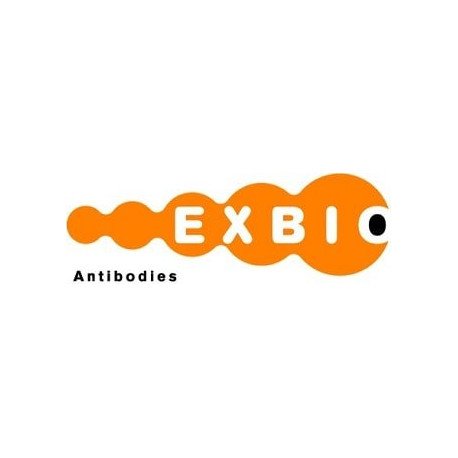Cart 0 Product Products (empty)
No products
To be determined Shipping
0,00 € Total
Prices are tax excluded
Product successfully added to your shopping cart
Quantity
Total
There are 0 items in your cart. There is 1 item in your cart.
Total products (tax excl.)
Total shipping (tax excl.) To be determined
Total (tax excl.)
Data sheet of Mouse Monoclonal to Neurofilament heavy protein
| Brand | Exbio |
| Product type | Primary antibodies |
| Reactivity | Mammalian |
| Clonality | Monoclonal |
More info about Mouse Monoclonal to Neurofilament heavy protein
| Brand: | Exbio |
| Product no.: | 11-256-C025 |
| Product type: | Primary antibodies |
| Host species: | Mouse |
| Product name: | Mouse Monoclonal to Neurofilament heavy protein |
| Antigen: | Neurofilament heavy protein |
| Clonality: | Monoclonal |
| Clone: | NF-01 |
| Isotype: | IgG1 |
| Immunogen: | Pellet of porcine brain cold-stable proteins after depolymerization of microtubules. |
| Format: | purified |
| Specificity: | The antibody NF-01 recognizes a phosphorylated epitope on heavy neurofilament protein (210 kDa) of various species. Antibodies to the various neurofilament subunits are very useful cell type markers since the proteins are among the most abundant of the nervous system, are expressed only in neurons and are biochemically very stable. |
| Categories: | Neurobiology (Veterinary), Neurobiology (Rodent), Neurobiology (Human), Cytoskeleton: Intermediate Filaments (Veterinary), Cytoskeleton: Intermediate Filaments (Rodent), Cytoskeleton: Intermediate Filaments (Human), Cytoskeleton: Intermediate Filaments |
| Concentration: | 1 mg/ml |
| Storage buffer: | Phosphate buffered saline (PBS) with 15 mM sodium azide, approx. pH 7.4 |
| Storage / stability: | Store at 2-8°C. Do not freeze. Do not use after expiration date stamped on vial label. |
| Background: | Neurofilaments (NFs) are a type of intermediate filament (IF) expressed almost exclusively in neuronal cells, and in those cells most prominently in large axons. NFs in most vertebrates are composed of three different polypeptide chains with different molecular weights – neurofilament heavy protein (NF-H), medium (NF-M) and light protein (NF-L), which share sequence and structural similarity in a coiled-coil core domain, but differ in the length and sequence of their N-termini and more dramatically of their C-termini which in the case of NF-M and NF-H form the flexible extensions that link NFs to each other and to other elements in the cytoplasm. The protein segment on the C-terminal side of the human NF-H rod is uniquely long (more than 600 amino acids) compared to other IF proteins and is highly charged (> 24 % Glu, > 25 % Lys), rich in proline (> 12 %) and improverished in cysteine, methionine and aromatic amino acids. Its most remarkable feature is a repetitive sequence that covers more than half its lenght and includes the sekvence motif Lys-Ser-Pro (KSP) greater than 40 times. Plasma neurofilament heavy chain level has been proposed as a marker of axonal injury and clinical use of its degeneration and loss has been suggested as a biomarker of several neurodegenerative diseases. |
| Purity: | > 95% (by SDS-PAGE) |
| Purification: | Purified by protein-A affinity chromatography |
| Product specific references: | *Lukas Z, Draber P, Bucek J, Draberova E, Viklicky V, Dolezel S: Expression of phosphorylated high molecular weight neurofilament protein (NF-H) and vimentin in human developing dorsal root ganglia and spinal cord. Histochemistry. 1993 Dec; 100(6):495-502. |
| General references: | *Cote F, Collard JF, Julien JP: Progressive neuronopathy in transgenic mice expressing the human neurofilament_x000D_ heavy gene: a mouse model of amyotrophic lateral sclerosis. Cell. 1993 Apr 9;73(1):35-46. _x000D_ , *Ohara O, Gahara Y, Miyake T, Teraoka H, Kitamura T:_x000D_ Neurofilament deficiency in quail caused by nonsense mutation in neurofilament-L gene. J Cell Biol. 1993 Apr;121(2):387-95. _x000D_ , *Petzold A, Keir G, Warren J, Fox N, Rossor MN: A systematic review and meta-analysis of CSF neurofilament protein levels as biomarkers in dementia. Neurodegener Dis. 2007;4(2-3):185-94._x000D_ _x000D_ , *Miyazawa I, Nakashima I, Petzold A, Fujihara K, Sato S, Itoyama Y: High CSF neurofilament heavy chain levels in neuromyelitis optica. Neurology. 2007 Mar 13;68(11):865-7._x000D_ , *Wild EJ, Petzold A, Keir G, Tabrizi SJ: Plasma neurofilament heavy chain levels in Huntington's disease._x000D_ Neurosci Lett. 2007 May 7;417(3):231-3._x000D_ |
| Related products: | - Mouse Monoclonal to NHERF1 / EBP50 - Mouse Monoclonal to Neurofilament medium protein - Mouse Monoclonal to NG2 / Chondroitin sulfate proteoglycan 4 |
| Shipping condition: | Room temperature |


